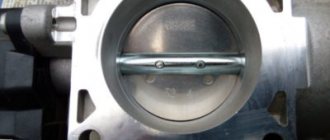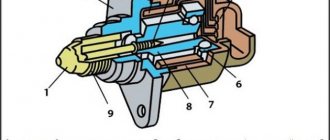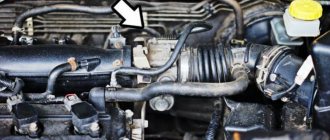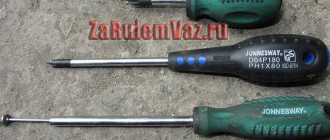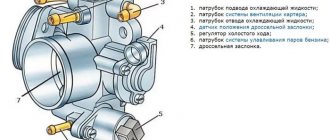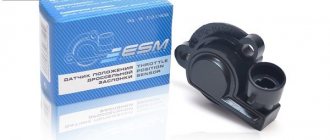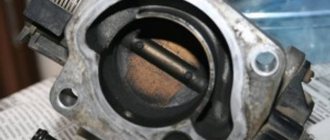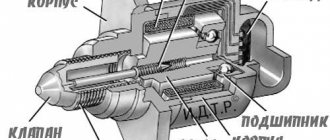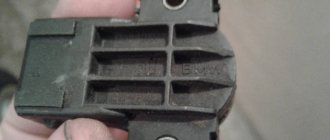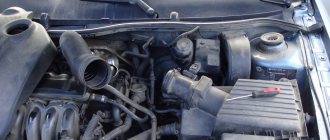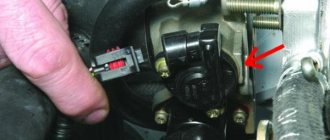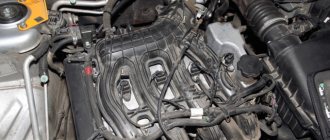The throttle valve itself is one of the most reliable engine components and replacing it is an extremely rare event. It cannot fail without outside physical intervention, but from time to time it requires the attention of the car owner. If the engine suddenly begins to run unevenly, the idle speed begins to fluctuate, the car responds worse to the gas pedal, this indicates that the throttle valve needs to be cleaned.
During vehicle operation, oil deposits form inside the throttle assembly, including on the damper and the idle air control rod, which over time begin to interfere with the free movement of the damper. It begins to wedge, which is why the unpleasant symptoms described above arise. To eliminate them, the throttle assembly must be removed and washed. How to clean it is written below.
Operating principle
The throttle valve plays the role of a special valve . When it is open, the pressure in the intake system is equal to atmospheric pressure. When the valve is closed, it drops to vacuum levels . The damper is equipped with one of two control options:
- Mechanical drive (for budget cars). The throttle valve is connected to the gas pedal with a metal cable.
- Electric drive (for modern models). In this case, an electronic system is used that can influence the engine torque value. This type of control also reduces fuel consumption.
The engine control unit receives signal impulses from the operating sensors and turns them into regulators of the influence on the throttle valve.
The throttle valve assembly includes a body, valve, electric motor, gearbox, spring return mechanism and condition sensors. To ensure reliable operation of the module, a pair of throttle position sensors are used. These functions are performed by potentiometers having a sliding contact or a magnetoresistive proximity sensor. If the wire turns out to be faulty, the emergency position of the throttle valve is activated using a return spring mechanism.
This is interesting: DIY car battery chargers
What is a throttle valve and how does it work?
The throttle valve, located between the intake manifold and the air filter, is one of the most important elements of a car's engine intake system. Despite the lack of need for this part for diesel cars, it is installed on them in case of engine malfunctions. Gasoline engines equipped with a valve lift control system also do not require a throttle valve, however, most often it is installed.
The task of this element is to supply and regulate the air flow that forms the air-fuel mixture. That is, the correct functioning of the valve affects how stable the engine will operate, how fuel will be consumed and how the car will function as a whole.
The throttle valve is essentially a bypass valve. When it is open, pressure equal to atmospheric pressure is maintained in the intake system. When the plug is closed, the pressure drops, approaching the vacuum value (since the engine functions as a pump). This is the reason for the connection between the brake booster and the intake manifold. Structurally, the damper is a round plate that rotates 90°. During one revolution, a cycle occurs from full opening to full closing of the valve.
The throttle valve block (module) consists of the following elements:
- Housings with pipes that are connected to ventilation systems, collecting fuel vapors and coolant (used to heat the element).
- An actuator that, when the gas pedal is pressed, moves the valve.
- Position sensors (potentiometers) that measure the valve opening angle and transmit a signal to the engine control unit. Modern systems are equipped with two sensors that monitor the position of the throttle valve. They can have sliding contact (potentiometers) or be magnetoresistive (non-contact).
- An idle speed regulator that maintains the required crankshaft speed when the element is closed. It provides a minimum throttle opening angle when the gas pedal is released.
What is the positive effect of cleaning the throttle?
During the operation of the car, dust particles and drops of oil settle on the internal and external parts of the throttle, which the air filter could not stop. These deposits can interfere with the smooth functioning of the intake system. This happens because when a dirty damper is opened, less air enters than is provided in the factory settings. This situation negatively affects the dynamic characteristics of the car.
Regularly cleaning the throttle body has the following positive aspects:
- Fuel consumption will correspond to factory standards .
- The amount of air supplied to the cylinders will remain in the optimal dosage in any operating mode of the power unit and will ensure uninterrupted engine operation.
- A clean throttle intake system will ensure responds quickly when you press the gas pedal, which is especially important when cornering and on slippery roads in winter.
- You can start the car quickly and reliably .
- When changing gears, the car will not stall , this will help to avoid emergency situations on the road.
It is worth highlighting several of the most common reasons leading to premature clogging of the throttle:
- Low quality motor fuel as a result of the use of additives to increase the octane number of gasoline. Additives are converted into carbon deposits that settle on the components of the intake system.
- Increased dust content in the air.
- Dirty fuel filter that was not replaced in time.
- Worn out engine.
If these factors are present, special attention should be paid to the cleanliness of the throttle valve.
Even a novice driver can identify the symptoms of a dirty throttle:
- The engine does not start well, especially after a long period of parking;
- The car responds slowly to pressing the gas pedal;
- The car jerks while driving;
- When switching to neutral, the engine sometimes stalls;
- Fuel consumption increases noticeably.
All these malfunctions indicate possible contamination of the throttle valve and the need to clean it.
Ways to increase throttle life
At the manufacturing plant, even at the production stage, the throttle valve wells are coated with a special molybdenum coating. If not carefully cleaned or during use, it can wear out and become damaged. But this is not a death sentence - such coverage can be restored.
For these purposes, special materials based on molybdenum disulfide are used - antifriction solid lubricant coatings, which are produced both in liquid form and in aerosol packaging.
The MODENGY line of materials includes a special composition - MODENGY anti-friction solid lubricant coating for internal combustion engine parts. It is used to restore the factory coating on throttle valves, as well as to protect other engine elements: piston skirts, splines, plain bearings, threaded connections, etc.
This material is applied by spraying from an aerosol can from a distance of 15-20 cm. A distinctive feature of the coating is the ability to cure at room temperature. ATSP can be applied in several layers with intermediate drying for 20 minutes.
The coating kit includes the MODENGY Special Cleaner-Activator. This is a finishing agent that removes remaining contaminants from surfaces and ensures the best adhesion of ATSP to the base of the parts. This material can also be purchased separately from the coating.
Cleaning algorithm
Now we will give a step-by-step algorithm for properly cleaning the throttle valve.
- First of all, you need to get to the damper itself. The design is different in different engines. But as a rule, to do this you need to remove the air duct that runs from the damper to the air filter.
- Dismantle the damper. To do this, unscrew several mounting bolts (2-4 pieces), and also disconnect the necessary connectors (for example, the connector from the absorber purge valve).
- To clean, you must use a carburetor cleaner. There is a wide variety of them, and in auto stores you can easily find a product in accordance with your preferences and capabilities (we will talk about them later).
- Using a rag and the mentioned product, you must thoroughly wipe the damper outside and inside.
- You also need to clean the protective grille (if your car has one).
- Assembly of the unit is carried out in the reverse order.
Remember that you need to clean the damper thoroughly so that the metal is as light as possible. This will ensure, after its installation, an increase in the dynamic characteristics of the machine.
An easy way to clean your throttle body
The correct way to clean the throttle body
Removing and cleaning the throttle valve
First you need to remove the mechanism itself, for which the throttle body should be disconnected from the air corrugation. If your vehicle has a manual throttle, you will also need to disconnect the accelerator cable.
After this, you need to disconnect the cooling system fluid hoses. It must be remembered that work should not be carried out on a hot engine, as serious burns can occur. After disconnecting the hoses, you need to make sure that there is no more liquid in them. When the housing is completely freed, you need to remove the throttle valve gasket and the valve itself. As a rule, to secure it, a pair of nuts or bolts are used, which we need to unscrew. If you notice contamination, the base of the collector must be thoroughly cleaned. In addition, we recommend replacing the gasket.
Cleaning without removal
Also, many car owners are interested in the question of how to clean the throttle valve without removing it. Such methods do exist, but you must immediately understand that high-quality cleaning is only possible by dismantling the damper .
To do this, you will need a special product - an intake tract cleaner. You can use different brands. You can also use EGR valve cleaning fluid, WD-40, and solvents for cleaning.
So, the procedure without removing the node :
- As in the previous algorithm, you need to remove the air duct to get to the damper.
- With the damper closed, spray the surface with cleaning liquid and remove the cleaned dirt using a rag.
- Open the damper and remove dirt from the side surface.
- Make sure that the cleaning agent gets into all channels. The cleaning procedure is similar using a rag.
Let us repeat once again that for proper cleaning, the throttle valve must be removed from the car. And when installing it back, it is advisable to replace the damper gasket with a new one. Fortunately, its price is low.
As the manufacturers of such products say, they need to be used every 7...10 thousand kilometers. The damper must be cleaned and dismantled every 30...50 thousand kilometers.
It should also be remembered that in most cases, after cleaning the throttle valve, it is necessary to perform actions to “train” it . This procedure is carried out either using a computer (by connecting it to the car's ECU), or by manipulating the ignition and gas pedal. In this case, it is impossible to give universal recommendations, since they can differ significantly for each manufacturer and even model. Remember this!
Causes of pollution and how to deal with them
There are several reasons why the throttle body becomes dirty over time. By avoiding their appearance, you will automatically extend the time between cleaning it. Reasons mentioned include:
- Using low-quality gasoline . If there is sediment in it, it will definitely get into the throttle assembly, where it will turn into carbon deposits. Therefore, try to fill in high-quality gasoline and refuel at proven gas stations.
- Clogged fuel filter . If you do not change the fuel filter in time, then there is a possibility that pieces of dirt from it will get into the fuel system, including the throttle assembly.
- Dust and dirt getting into the intake system . This can be caused by various reasons - clogged air filter, damage to the integrity of the air duct, various mechanical stress.
- Crankcase gases with oil dust . They are the main cause of oil deposits on the valve. They can enter the combustion chamber through the valve cover from the crankcase ventilation system. The situation is aggravated by the fact that they carry oil dust. It is this that burns and remains as sediment on the surface of the throttle valve.
Clogged fuel filter
Change the air and fuel filters on time, fill with high-quality gasoline, and prevent dust from getting into the car's fresh air ventilation system. All this will save you from the need to clean the throttle valve ahead of schedule.
This is interesting: The order of operation of the engine cylinders: simple about the complex
Causes of clogging
The formation of a build-up on the surface of the valve is an inevitable process. Its reason is the removal of crankcase gases, which is necessary for the normal operation of the lubrication system. As a result, some of the oil gets onto the throttle valve. Due to high temperatures, the oil layer hardens and gradually thickens.
An additional factor is that gas combustion products settle on the oil layer. A coked build-up forms. It is impossible to reduce their influence; it is recommended to use good quality oil with a minimum content of third-party impurities. You should also observe the frequency of its replacement.
Incorrect operation of the air filter is also one of the causes of clogging. Some dust and other elements enter the system. This leads to accelerated formation of a layer on the throttle valve. The solution is to monitor the condition of the air filter, change it taking into account the manufacturer’s recommendations and actual operating conditions.
Cons of Cleaning the Throttle Body
All negative consequences of throttle cleaning are associated with an incorrectly performed procedure . This often happens when the work is carried out by the owner of the car himself or by an inexperienced service workshop technician. The most common errors leading to shortcomings in the throttle operation:
- Superficial cleaning of the throttle valve , without completely disassembling the entire module. Only a small part of the dirt is removed, and normal operation of the damper is not restored.
- Use a stiff brush instead of a soft rag. The mechanism is coated with a thin layer of molybdenum, which improves air flow. When cleaning carbon deposits with a hard object, you can easily damage the useful molybdenum coating.
- Neglecting the throttle adjustment after cleaning. The electronically controlled module requires additional training to adjust functionality.
- Cleaning the mechanism using force . May cause damage to throttle position sensors.
- Using homemade household chemicals not intended for cleaning automobile mechanisms.
Throttle cleaning work performed by professional repairmen requires financial expenses. This factor can also be attributed to the disadvantages of the procedure.
Possible mistakes
The first attempts to clean the throttle valve do not always lead to the desired result. In some cases, they can impair the performance of that machine component. The solution is to order a service from a specialized service or study the entire process in detail and choose the right, effective means.
Possible errors when performing cleaning:
- Processing frequency is not observed. Frequent impacts may disrupt the operation of the damper.
- Using rough rags or brushes will damage the surface.
- Removing the molybdenum layer, which is necessary to reduce air flow resistance. The layer is often confused with an oil coating.
- Throttle valve training is not carried out. This is necessary to set the idle speed.
- After 30-40 thousand km. mileage cleaning is carried out only with dismantling.
To effectively remove dirt and deposits, you need to properly dismantle the unit, select the optimal composition and carry out work with minimal physical impact on the surface. The result of this will be long-lasting operation of the throttle valve and the entire vehicle.
Did you like the article? Share on social media networks:
Recommendations
It would be most reasonable to entrust the work of cleaning the throttle valve to car service technicians . If for some reason the driver decides to carry out this procedure on his own, then he has two cleaning options:
- Superficial cleaning . The unit is not dismantled, and dirt is removed only from the visible surface using a rag soaked in a solution. The method is simple, but ineffective.
- Deep cleaning . Using special tools, the damper module is completely disassembled. Solvent is applied to all parts, then it is removed with a rag along with the dirt. After assembling the unit, the correct operation of the valve must be checked.
Only use special cleaning agents intended for use in cars!
Symptoms that may occur when the throttle is clogged
- When the throttle valve is clogged, there is some sluggishness in the response to the gas pedal . An engine with a clean throttle body responds to the accelerator much more quickly.
- Accumulated dirt in the throttle restricts air flow and can cause the engine to run rough at idle, the speed “floating”.
- The vehicle may at low speeds and speeds.
- With a very high degree of pollution, unauthorized engine stops are possible, i.e. the car stalls .
- Fuel consumption. The engine ECU (computer), recognizing that the air flow is too weak, increases idle speed, thereby increasing fuel consumption .
What to do to prevent the damper from getting dirty too quickly
Its condition will depend on the frequency of replacing the air filter, the use of high-quality internal combustion engine oil, and the serviceability of the oil separator of the crankcase gas recirculation system. In general, the cleaning procedure is not labor-intensive and not expensive. Therefore, if the above symptoms occur, or simply during maintenance, it is recommended to check the condition of the throttle valve. The resource of the node itself is very high, but it is worth keeping an eye on it, since it performs quite important and delicate work.
What is this?
The throttle valve is located directly in front of the intake manifold. It ensures that air enters the manifold, which means that the more it is opened, the more air will be let through. A mixture of air and fuel is then formed and enters the combustion chamber. When the driver of the car presses the gas pedal, he can adjust the position of the throttle valve, closing it or opening it. The gas cable connects the accelerator pedal to the throttle (unless you have an electronic gas pedal).
Quick cleaning
If you want to temporarily restore normal operation of the damper to wait until a normal repair can be made, you can use the quick cleaning technique. To do this, you don’t need to dismantle anything - just remove the corrugated hose leading from the air filter to the intake tract and assess the condition of the unit. If you see heavy contamination and soot particles inside, you can be sure that the throttle valve is the cause of the unstable operation of the engine.
It is better to use special means
The function of regulating the air supply to the intake manifold of the power unit is performed by the throttle valve. Interacts:
- Mechanically driven;
- With an electric motor.
These mechanisms are responsible for the timely opening and closing of the damper. Cleaning the throttle body is done infrequently. Work must be performed only when there are clear signs of malfunctions in the operation of this unit.
How often do you need to clean the damper, performing this manipulation
If you notice such “symptoms” in your vehicle, it is important to immediately inspect the integrity of the throttle assembly, and then immediately begin cleaning it.
These signs include:
- the appearance of floating speeds, which are easy to detect when the engine is idling (they can be noticed by the appearance of unevenness and lack of coherence in the functioning of the engine);
- the tachometer needle will always be in motion;
- difficulties starting the engine (this phenomenon occurs even if the engine has just stalled and remains hot);
- increased fuel consumption compared to the previous operation of the machine;
- loss of power in a vehicle with a large engine volume.
To determine whether the throttle valve needs to be cleaned, you need to inspect it. What does this give? Thanks to this manipulation, it is possible to understand the condition of the valve, as well as assess the degree of contamination. To remove this part, you need to remove the pipe that comes from the air filter, and then look into the throttle assembly. If it is dirty, it will be noticeable by a layer of dirt on the body and walls of the spare part.
Of course, it is better to contact a car service to clean the damper, but if the driver has extra time and desire, this manipulation can be carried out at home, especially since all designs of the throttle assembly are approximately the same.
Recommendations for cleaning the damper that can be given to novice car enthusiasts:
- if you start cleaning, then the throttle should be removed completely in order to clean not only the outer part, but also the inside;
- The cleaning product should be chosen carefully so that it does not harm the car parts;
- When cleaning, do not use rough cloths or brushes with hard bristles, as they can damage the molybdenum layer, which is necessary for improved air passage;
- The damper is cleaned once every 10 thousand kilometers, so it is not recommended to carry out this manipulation too often.
Why clean the damper, and what does this manipulation give?
Cleaning has a positive effect not only on the throttle assembly, but also allows the car to work normally.
How often should the part be cleaned? It should be done infrequently so as not to spoil the condition of this unit.
The process for cleaning the damper is as follows:
- Remove the pipe leading from the filter to the throttle. To do this, you just need to loosen the screw located on the clamp.
- Disconnect the 2 hoses, which are also attached with a clamp. They are located on both sides of the part. After this, disconnect the contact located on the throttle.
- We unscrew the bolts that are located around the base of the unit, while gradually removing the assembly from the manifold.
- We wash the removed spare part - for this we use a liquid intended for washing the carburetor, which is called carb cleaner. It is important to note that after removing a part, it must be cleaned immediately.
- After the liquid has been drained, it is advisable to replace the rubber gasket.
- Now we wipe the part again with a good cloth, and then assemble the throttle assembly in the reverse order (if the unit is dirty, wash it with the product again).
What should you pay attention to?
Cheap compounds should not be used, as they will contain aggressive elements that will not have the best effect on the condition of the throttle assembly. On average, this detergent should cost 100-150 rubles. It is important to use a soft, lint-free cloth for wiping.
As you can see, cleaning the damper is not at all difficult. Before you let the professionals wash the damper so that they can clean it and put it in order, you need to try to do this manipulation yourself, because it is not difficult to do - everyone who washed it says that it takes 20 minutes.
Most domestic drivers are already accustomed to performing minor car repairs at home. Pumping the brakes, changing the oil - no self-respecting car enthusiast will deny himself the pleasure of “poking around” under the hood of his car. The same applies to such a simple operation as cleaning the throttle valve. We will discuss later in the article how to do all the work correctly and what tools should be used.
Let's figure out why the throttle gets clogged
Like any vehicle component, the throttle valve must be serviced periodically. A common problem with this unit is blockage.
The throttle can become clogged for several reasons.
:
- Dust on the roads. Despite the location of the damper after the air filter, dust particles still enter the throttle air duct. If the filter itself is already dirty, then larger dust fractions enter the choke.
- Crankcase ventilation. On many modern cars, crankcase gases are cleared of oil in the oil separator and enter through the throttle into the intake system along with ordinary air. This principle is being implemented to comply with environmental standards.
- Exhaust gas recirculation. This system began to be used relatively recently, but has already become popular among automakers. The exhaust gases from the exhaust manifold again flow through the throttle into the intake for afterburning.
Now imagine that oil particles from the crankcase gases combine with dust and/or carbon particles from the exhaust gases. A dirty, oily film is formed, which constantly settles on the damper. After tens of thousands of kilometers, a layer of this dirt will disrupt the operation or completely disable the throttle assembly. Therefore, periodic cleaning of the throttle body is important for proper engine operation.
Why does the throttle valve become dirty?
It is impossible to prevent or stop this process. The removal of crankcase gases is necessary, because otherwise the oil will very quickly lose its lubricating properties, and extreme pressure will quickly build up in the lubrication system, and the oil will be squeezed out through all the seals (gaskets, oil seals, oil dipstick). In all engines, crankcase gases are discharged not into the environment, but into the air system to improve the environmental friendliness of the engines.
By themselves, crankcase gases could pass through the throttle valve with virtually no damage to the engine (except for some deterioration in the quality of the working mixture), but their constant companion is oil mist.
Oil attracts the dirty component of gases and, settling on the surfaces of the throttle assembly, forms a deposit that needs to be cleaned.
How does the remote control become contaminated?
A lot of all kinds of deposits accumulate on the walls of the damper, which block the passage of air at small opening angles of the remote control. Obviously, this was not initially provided by the manufacturer. Engineers calculated the dynamics of the car based on normal indicators, for pure remote sensing, as they say. For this reason, as soon as the damper becomes dirty, traction begins to fail. After proper cleaning, all processes are improved, including fuel consumption.
Cleaning the engine protection is mandatory after washing the injector nozzles. In addition, the procedure is recommended for carrying out after the simultaneous appearance of 2-3 of the signs described above (maybe all together).
It will be useful to know that the main source of contamination of the remote control is the filtration (operation) of the crankcase. On older engines, oil deposits come out of the crankcase. The steam settles and cools, turning into deposits.
Do I need to check the remote control often? Yes, if the car is used, definitely. This must be done every time you service the power unit. If traces of carbon deposits are visible on the valve, as in the photo, it is necessary to urgently begin the procedure for cleaning the throttle valve.
If the car has a remote control and IAC, then the sensor also needs to be thoroughly washed.
How do you usually clean the throttle body?
If we go the more painstaking and thorough route, we will need a screwdriver, a set of wrenches, carburetor cleaner and rags. Yes, yes, carburetor cleaner, even if you have an injection car. Historically, carburetor cars were first invented, which also required timely cleaning. Therefore, chemists came up with a carburetor cleaner that perfectly dissolves all the slag that has accumulated in it. Since the nature of the origin of the deposit is the same for both carburetor and injection cars, the name “carburetor cleaner” has stuck around.
What may indicate increased soot
The driver must know what signs can be used to identify a malfunction or malfunction of the unit. These include:
- Unstable, intermittent operation of the power unit. The car jerks at speeds less than 20 km/h;
- The idle speed “floats”, the power unit stalls;
- Possible freezing of engine speed;
- Dips in engine speed until a complete stop;
- The engine is difficult to start.
In this regard, the question arises of how to clean the throttle valve and what products to use. So, everything in order. There are two ways to resolve the issue. Clean the throttle valve yourself or contact a service station.
On a note. When carrying out cleaning, you should know that the process in question is recommended to be performed after the vehicle has traveled more than 100 thousand km.
In exceptional cases, cleaning of the unit is carried out when the vehicle has been driven after 30 thousand km. In order not to create confusion and vacillation in this matter, you should adhere to the manufacturer’s recommendations.
Signs of contamination
The main signs of deposit formation are changes in engine operation. However, this may not always be due to contamination. Sometimes the problem is caused by a sensor malfunction, drive failures, or incorrect settings of the on-board computer parameters. Diagnosis is needed to identify the exact causes. Often, improper throttle operation occurs due to two or more reasons.
- There is no stable operation of the engine at idle speed, it stalls.
- The startup time of the power unit increases.
- At speeds up to 20 km/h, the car jerks when pressing the accelerator pedal.
- Dips in speed, up to a complete stop of work.
XDo you still think that diagnosing a car is difficult?
If you are reading these lines, it means you are interested in doing something in the car yourself and really saving money.
, because you already know that:
- Service stations charge a lot of money for simple computer diagnostics
- To find out the error you need to go to specialists
- The services use simple impact wrenches, but you can’t find a good specialist
And of course you are tired of throwing money down the drain, and driving around the service station all the time is out of the question, then you need a simple CAR SCANNER ROADGID S6 Pro, which connects to any car and through a regular smartphone you will always find the problem, turn off CHECK and good save money!!!
The throttle valve in modern automobile gasoline engines is a device that, along with other systems, is responsible for regulating the composition of the fuel-air mixture entering the cylinders for combustion. For various engine operating modes, a strictly defined qualitative and quantitative composition of the combustible mixture is required, and its violation can lead to unstable engine operation in the corresponding modes, loss of power of the power plant and increased fuel consumption. That is why the full functional performance of the throttle valve is important, which can be impaired by contamination during vehicle operation.
Why does the throttle valve become dirty?
In addition to the fact that pollution itself is a natural process for any operating mechanism, the intensity of pollution of the throttle valve is increased by the crankcase ventilation and exhaust gas recirculation system, which, in accordance with environmental requirements, direct harmful substances for afterburning into the fuel mixture.
As a result of their work, a persistent coating of tarry deposits appears on the throttle valve. How often should you clean the throttle valve
? The throttle valve should be cleaned as it gets dirty. On average, this can happen once every 30,000-50,000 km. Its contamination can be determined by the following signs of disruption of normal engine operation:
- unstable engine operation at idle with periodic sharp decrease in speed and subsequent sharp increase (so-called “dips”);
- jerks while driving at low speeds due to unstable operation of the idle system;
- the tendency of the car to stall when trying to drive immediately after starting a cold engine.
In general, any changes in the normal operation of the engine at idle speed can be caused precisely by contamination of the throttle valve. The whole point here is that at idle the engine operates with the throttle valve almost completely closed and any changes in the flow area between the throttle and its body, necessary for stable idling, immediately affect the operation of the engine just at idle.
To make sure that the throttle valve needs to be cleaned, you need to remove the pipe going to the throttle valve from the air filter side and, gently pressing on the throttle valve, move it to the partial or full open position. If dirt is clearly visible, then this unit needs cleaning.
How to clean the throttle body
There are no particular difficulties in cleaning the throttle valve. This procedure can be carried out efficiently only by completely removing the throttle valve from the engine. Let's look at the process of cleaning the throttle using the example of a 1.8-liter Duratec family engine in a Ford Focus car. After these steps, all problems with engine idling that were associated with contamination of the throttle valve should disappear. The power plant will again delight you with stable operation at idle and under load when moving from low to high speeds.
Common Mistakes
Often, novice car enthusiasts, after the above symptoms appear, immediately remove the throttle assembly for further cleaning. First of all, the damper should simply be inspected for the appearance of deposits. If you don’t see them, you should look for the problem in other nodes.
We do not recommend rushing through cleaning. First you need to make sure that this procedure is really necessary. It is better to clean the damper already removed from the engine. This will allow you to achieve much better results. Do not use rags too actively (more on the cleaning process below)!
Cleaning the unit: stages and sequence of work
There are two cleaning options: without removing the unit and after dismantling. In the first case, the effectiveness of soot removal will be minimal. Cleaning without removal is carried out only in extreme cases, since carbon deposits are removed only from the damper, and deposits remain on the walls and air channels.
Complete cleaning gives a more noticeable effect. Work begins with removing the unit, which is located between the intake manifold and the engine air filter.
On cars from different manufacturers, the work may differ, but not significantly. On most vehicles this happens as follows:
- the corrugation connects the damper with the air purification filter: it must be removed first;
- Next, turn off the throttle position and absolute pressure sensor (if available and installed on the car);
- then you need to squeeze out the weight that secures the accelerator pedal cable;
- dismantle (disconnect) the coolant pipes. At this stage, work must be carried out very carefully. If the power unit has not completely cooled down, hot drops of technical fluid can cause a burn if they come into contact with human skin, remember this;
- Disconnect the crankcase gas and absorber ventilation hoses;
- Then you need to unscrew the fastenings of the throttle assembly and dismantle it.
Having removed the mechanism, unscrew the idle speed control. Its washing and cleaning is highly desirable. To rinse the entire assembly, you must use special products.
Do not forget! Before washing the unit using chemicals, be sure to remove all rubber elements to prevent them from becoming deformed.
Washing the throttle valve is possible using budget detergents ("Karbakliner") and more effective, but expensive ones. Read about it below.
Self-cleaning the throttle valve
It is possible to clean the damper without removing it, but only as a preventive measure. This will not help remove all contaminants, since there will not be full access to the unit. After stopping the engine, you need to wait 1-1.5 hours. Then remove the air duct. The throttle valve is in the closed position. A cleaner is applied to its surface. After it has dried, open the valve manually and process the internal elements.
How often to clean depends on the operating conditions. Dirt removal without dismantling is done every 5-7 thousand km. mileage With dismantling - 30-50 thousand km. But these are conditional indicators, the frequency is determined by the owner of the car after a visual inspection and the appearance of signs of contamination.
Removal
Before removing the throttle valve, check that the engine is cool. Otherwise, there is a risk of burns. Carry out work in a well-lit place. This is necessary for convenient disconnection of external components.
- Remove the air duct corrugation.
- Disconnecting the idle circuit wires.
- Disconnect the throttle position sensor.
- Disconnect the hoses. It is advisable to plug their pipes, for example, with spark plugs.
- Removing the unit. To do this, you need to unscrew 2 or 4 bolts. If the thread does not feed well, treat it with lubricant.
You need to remember the dismantling order so that after the work there are no installation difficulties. Fold the individual elements.
Cleaning and installation
It is not recommended to use a container to completely immerse the unit. There are aerosol-type products that can treat the outer and inner surface of the throttle valve. Work is performed on a table or any other flat surface with good lighting. The room is ventilated, the temperature should not be lower than +5°C.
- Treat the outer and inner surfaces.
- Check for dirt and build-up.
- Mechanical treatment only with dry rags.
- If necessary, repeat cleaning, waiting until the surface has completely dried.
Pay attention to the condition of the crankcase ventilation channel and the location of the needle. This is where dirt accumulates the most. Additionally, clean the idle air regulator. If the condition of these elements is unsatisfactory, there is play in the needle movement, the entire unit needs to be replaced.
Before reinstallation, the condition of the gasket is checked. It should not have ruptures or deformations. It is advisable to replace it with a new one. Installation is carried out in the reverse order, checking the reliability of fastening of the connections.
What is throttle adaptation or learning
DZ can be washed at home, although this largely depends on the car model. For example, if the car has a cable-operated, mechanical gas pedal (standard), you can safely start cleaning. Not at all, if an electronic throttle is installed, the situation changes. Adaptation may be needed.
The adaptation is reset either from the scanner or forcibly when the accelerator pedal is simply pressed all the way and the accelerator pedal is lowered when the internal combustion engine is standing. Adaptation is nothing more than a decrease in throttle angle (throttle opening angle). Often, after flushing the electronic throttle, the throttle valve opens more than necessary.
There are people who claim that after several tens of kilometers the remote sensing system automatically adapts, but this is not so. There have been cases when, even after 200 km, the car remained at floating speed. They instantly disappeared after forced adaptation.
Here's how training (adaptation) is carried out:
- the battery current is checked, which should be within 12.9 volts (with the engine standing);
- the temperature of the antifreeze is checked (should be 70-99°);
- the gearbox must be thoroughly warmed up and the steering wheel must be in neutral;
- The car should be placed on a level surface, all consumers should be turned off.
After that:
- start the engine and count to five;
- then quickly press the gas pedal all the way and release (repeat 5 times);
- After that, count to seven, and then press the accelerator pedal all the way and hold it until the Check indicator starts flashing;
- release the pedal after this, counting to three;
- start the engine again if it stalls and count to twenty;
- give gas and check that the speed automatically returns to standard in idle mode.
